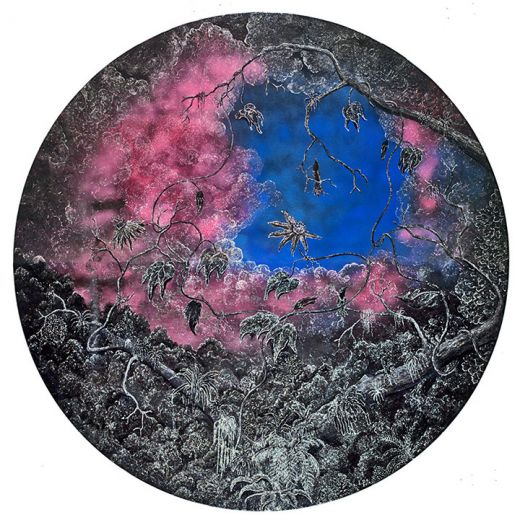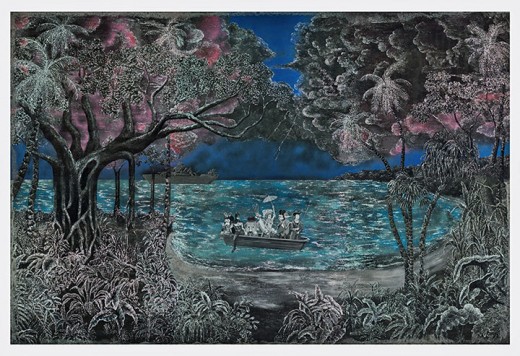Edouard Duval-Carrié, Imagined Landscapes
Michelle Rodriguez

Edouard Duval-Carrié, After Heade–Hummingbirds, 2013. Mixed media on aluminum, 96 inches diameter. Courtesy of the artist Photo credit: Ralph Torres.
March 13 – August 31, 2014
This piece is contributed by Michelle Rodriguez, The Miami Rail’s new teen correspondent. Rodriguez is a junior at Young Women’s Preparatory Academy.
Through in-depth research and the works of other artists, Haitian-born, Miami-based artist Edouard Duval-Carrié creates a glittery, yet subtly grim, tropical environment in his Imagined Landscapes exhibition at the Pérez Art Museum Miami (PAMM). Consisting of eleven paintings and two chandelier-sculptures, the exhibit alludes to the 19th century works of artists such as Martin Johnson Heade, Frederic Edwin Church, and Albert Bierstadt who were commissioned to portray the Caribbean and Florida as picturesque paradises. Although the elaborate decoration of Imagined Landscapes is evocative of a Rococo palace, the concepts the paintings convey are anything but.

Edouard Duval-Carrié, After Bierstadt–The Landing of Columbus, 2013. Mixed media on aluminum, 96 x 144 inches. Courtesy of the artist. Photo credit: Ralph Torres
Duval-Carrié also touches on the subject of Western globalization. Minnie Mouse, Bugs Bunny, Marie Antoinette, and Christopher Columbus are some of the characters that reach a sandy shore, while behind them a combat ship floats over shimmery, blue waters in “After Bierstad- The Landing of Columbus.” Meanwhile in “Liberty,” a female silhouette with a body full of silver-glitter geometric motifs and a star-shaped head commendably raises her arms in front of a sky layered with a pattern that is reminiscent of Louis Vuitton’s iconic floral design. Both paintings manage to effectively hint at a modern culture that was somewhat forcibly integrated onto newly discovered territory and its original inhabitants through the exposure of historical Western symbols.
Although the glitter and alluring colors of Imagined Landscapes makes a glamorous impression, Duval-Carrié uses this glitz in the same way the 19th-century artists used their Romanticist aesthetic visions—to influence a distinct, individual perspective of valuable tropical territories onto spectators. Duval-Carrié just chose to display a darker side.










